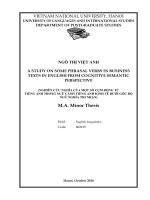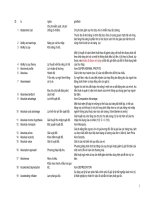Case study tiếng anh kinh tế
Bạn đang xem bản rút gọn của tài liệu. Xem và tải ngay bản đầy đủ của tài liệu tại đây (129.26 KB, 7 trang )
VIETNAM NATIONAL UNIVERSITY
University of Languages and International Studies
ENGLISH FOR ECONOMICS
CASE STUDY: MARKET COMPETITION
THE RISE AND FALL AND RESURRECTION OF BUBBLE TEA IN
VIETNAM
Lecturer: Cấn Thị Chang Duyên
Name: Trần Ngọc Huyền
Class: 19E8
Student ID: 19040461
Ha Noi - 2021
1
TABLE OF CONTENT
I.
Introduction…………………………………………………………...3
1.1. Purposes………………………………………………………... .3
1.2. Background information………………………………………....3
II.
Conceptual background……………………………………………….3
III.
Analysis…………………………………………………………….....4
3.1. Situations, problems and reasons………………………………....4
3.2. Solutions……………………………………………………….....6
IV.
Conclusion………………………………………………………….....6
V.
References……………………………………………………………..7
I. Introduction
2
1.1. Purpose of the report
The aim of this report is to present the Vietnam bubble tea market based on the
theoretical frameworks of market competition. Specifically, by analyzing the
situations and problems of the market throughout the years, the paper will point
out some main reasons behind the cases, then give several solutions to address the
problems.
1.2. Background information
Bubble tea is a kind of beverage that originated in Taiwan in the early 1980’s.
These drinks. It is usually cool, refreshing, sweet with tapioca balls laying on the
bottom cups. Having a pleasant taste, bubble tea soon became popular in most
parts of East and Southeast Asia countries, especially in Vietnam in the 2000s.
Since being introduced to Vietnam, the bubble tea market has been subject to
considerable fluctuation. However, in recent years, people witnessed the revival of
this market with a dizzying increase of milk tea shops across the country.
II. Conceptual background
It is essential for us to understand some theoretical framework and define key
concepts related to the case. Firstly, according to market competition is rivalry in
which sellers of homogenous products or services try to achieve revenue, profit
and market share growth (Carnrite, 2021). Secondly, it can be seen that the bubble
tea market operates in monopolistic competition where many firms selling the
products are similar but not identical (Division of English for special purposes,
2020). There are three main features of monopolistic competition: many sellers,
product differentiation and low entry barriers (Division of English for special
purposes, 2020). The market for bubble tea, for example, has numerous shops in
Vietnam such as Ding tea, Phuc Long, Koi, etc. The product differentiation is
expressed through the difference in flavour, toppings of cups of milk tea from
different firms. Finally, the low entry barriers allow the firms to freely exit and
enter the market without restrictions, which make it easy for people to start a milk
tea shop.
III. Analysis
3
3.1 Current situations, problems and reasons behind them of milk tea market
According to the Dan Tri newspaper,
milk tea was probably introduced in
Vietnam around the 2000s. On the market at that time, most milk tea businesses
were just small and spontaneous in the form of street carts or shops with a few
plastic chairs for customers. The sales management process was sketchy and
unprofessional. Moreover, the milk tea products were unbranded with simple
flavours including chocolate, mint, fruits. The reason behind this was that bubble
tea was a new market, leading to the inexperience in management and business.
However, due to its low price (about 10.000 - 15.000 VND) and deliciousness,
bubble tea still became a fever among adolescents; Besides the high demand, the
huge profit also contributed to the development of bubble tea during the 2000s.
According to an analysis by Vietnamnet newspaper, it only cost about 30.000 40.000 VND per of milk tea powder and 15.000 - 17.000 VND per pack of
bubble, which could make about 20 cups of milk tea. Including other costs, the
estimated original price of a milk tea cup was less than 3.000 VND. Therefore,
the sellers can make double or even triple profits (VTC, 2013).
The bubble tea market experienced a strong growth but soon became unpopular in
late 2009 because of the rumors related to the origins of ingredients. The number
of consumers suddenly decreased, which led to the shrink of milk tea markets
(VTC, 2013).
The milk tea market continued to decline until 2013 when Ding Tea, a large milk
tea brand, was introduced in Vietnam. From 2013 to 2019, this market was
prosperous with numerous famous brands such as Goongcha, Royaltea, Goky, etc.
It is estimated that there are more than 1,500 bubble tea businesses in Vietnam,
with over 100 different brands (The Rise and Fall. . . and Resurrection of Bubble
Tea in Vietnam, 2017). Moreover, a survey by the market research company
Q&Me shows that 73% of the respondents said that they recognized bubble tea.
Besides
the quantity, the quality of bubble tea shops also improved with
professional management processes and product differences. The first reason for
the boom of the bubble tea market is increasing demand, especially among youth.
4
According to Vnexpress newspaper, the survey of 210 Gen Z in Ha Noi and Ho
Chi Minh found 81 percent of interviewers saying milk tea shops were their
favorite hangouts (Nguyen, 2019). Another reason behind the irresistible lures of
this market is the high profits. According to Nguyen Phi Van, executive director
of Retail & Franchise Asia, entrepreneurs can earn up to 40 percent of profits on
each cup of milk tea. Due to the outbreak of Covid 19, the milk tea market in
Vietnam shows a sign of slowing down. Many milk tea brands had to relocate or
return the rental space. The Alley brand, for example, had to close five shops in
HCM city during Covid 19 pandemic (Anh, 2021). However, this situation
promoted the form of selling milk tea online, which made the milk tea market
stable again. As a survey by Garb, a food delivery company, during the social
distancing period in Ho Chi Minh City, the company's preliminary statistics show
that milk tea is the most ordered dish on the app (Vu, 2021). Although people are
optimistic about the future of the milk tea business at present, owners of milk tea
shops have to encounter fierce market competition due to low entry barriers.
Moreover, the increase in franchise fee and health consciousness of consumers are
expected to reduce the profit of the milk tea market.
3.2 Solutions for problems of milk tea market
In the face of the fact that the fierce competition among bubble tea companies
may hurt small and medium businesses, the Government has introduced the law
on competition for not only the bubble tea market but also for all domestic
markets. The law is responsible for controlling the act that causes the restriction of
the competition. Besides, it also protects the legitimate business rights of
enterprises from unfair competition. According to the Article 118 of Vietnam
Competition Law, the violations can result in fines of up to 10% of the total
revenue of the enterprise in the previous years (“Luat canh tranh (Viet Nam),”
2021). Besides, it is important to prevent ignoring the consumers' health of
businesses, so that the bubble tea market is able to develop in a sustainable way.
Therefore, the Government has not only promulgated the law on food hygiene and
5
safety but also collaborated with mass media companies such as VTC, VTV,
VnExpress to report and sanction the violations.
IV. Conclusion
The milk tea business is expected to grow strongly and bring huge profits for
investors in the near future. However, the potential customers of this industry are
young people who have constantly changing consumption habits. This requires
businesses to have a suitable strategy and high flexibility to survive in a highly
competitive market as bubble tea.
V. Reference lists
Anh H. (2021, May 24). Thị trường trà sữa Việt Nam trước tác động của
Covid-19. Kinh tế & Đồ uống. />Carnrite, J. (2021, September 21). What is Competition in Marketing? Definition
&
Types
[Slides].
Study.Com.
/>6
Dân Trí. (2018, August 17). Hành trình trà sữa tạo dấu ấn trong lịng teen
Việt. Báo điện tử Dân Trí. />Division of English for special purposes. (2020). English for economics.
Division of English for special purposes: Selective compilation for internal
use.
Luật cạnh tranh (Việt Nam). (2021, November 21). In Wikipedia.
/>%A1nh_tranh_(Vi%E1%BB%87t_Nam)
Nguyen, D. (2019, February 1). Generation Z motivates Vietnamese
entrepreneurs to open bubble tea shops. VnExpress International – Latest
News,
Business,
Travel
and
Analysis
from
Vietnam.
/>The rise and fall. . . and resurrection of bubble tea in Vietnam. (2017,
November 6). Nhan Dan Online - VietNam Nhân Dân Newspaper. Retrieved
April
11,
2021,
from
/>%E2%80%A6-and-resurrection-of-bubble-tea-in-vietnam.html?
PageSpeed=noscript
VTC. (2013, March 19). Trà sữa trân châu: Tàn đời vì tin độc hại.
Vietnamnet. Retrieved April 11, 2021, from />Vu, P. (2021, July 2). TP.HCM bùng phát dịch Covid-19: Trà sữa là chân ái
khi người Sài Gòn đặt nhiều nhất trên app. Báo Thanh Niên.
/>
7









